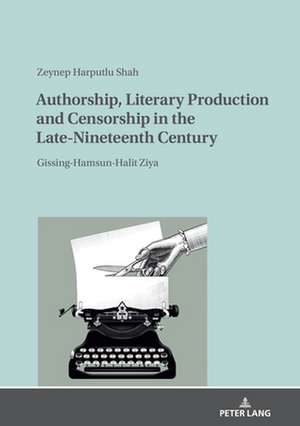Authorship, Literary Production and Censorship in the Late-Nineteenth Century
Autor Zeynep Harputlu Shahen Limba Engleză Hardback – 20 dec 2020
Has censorship always been a threat to authorship and artistic production? How did the mass market, the reading public, political or economic concerns influence authors¿ creativity and literary production in the late nineteenth century? Was self-censorship an individual choice based on voluntary action or fear in the period? How and to what extent did censorship have an impact on the content, form and structure of the novel genre? This book addresses these pivotal questions and examines the transforming notion of authorship, literary production and censorship with a particular focus on England, Norway and the Ottoman Empire. In the novel genre, George Gissing¿s New Grub Street (1891), Knut Hamsun¿s Sult (1890) and Halit Ziya Us¿akl¿gil¿s Mai ve Siyah (1898) portray the changing conditions of art and the artist and draws attention to the pressing need for artistic autonomy, self-expression and creativity in the period.
Preț: 282.12 lei
Nou
53.99€ • 57.73$ • 45.01£
Carte tipărită la comandă
Livrare economică 17 aprilie-01 mai
Specificații
ISBN-10: 363183800X
Pagini: 144
Dimensiuni: 148 x 210 mm
Greutate: 0.35 kg
Editura: Peter Lang Copyright AG
Notă biografică
Zeynep Harputlu Shah received her MA and PhD in English literature from King's College London and graduated in 2015. She is currently working as an assistant professor at Siirt University, Turkey. She has publications on nineteenth-century literature, urban literature and comparative literature.
Cuprins
A Short History of Printing and Book Production; Literary Authorship and Copyright; Censorship and Self-censorship; Victorian publishing; Norwegian literature; George Gissing; Knut Hamsun; Halit Ziya Usakligil; Censorship in the Ottoman Empire; Literary Production; The Novel Genre; Art and the Artist; Literature and Creativity.
Descriere
This project focuses in the construction of authorship, literary production and censorship practices in England, Norway and the Ottoman Empire in the late nineteenth century and examines paradoxical influences of (self-) censorship on art and the artist in New Grub Street (1891), Sult (1890) and Mai ve Siyah (1896-97).
